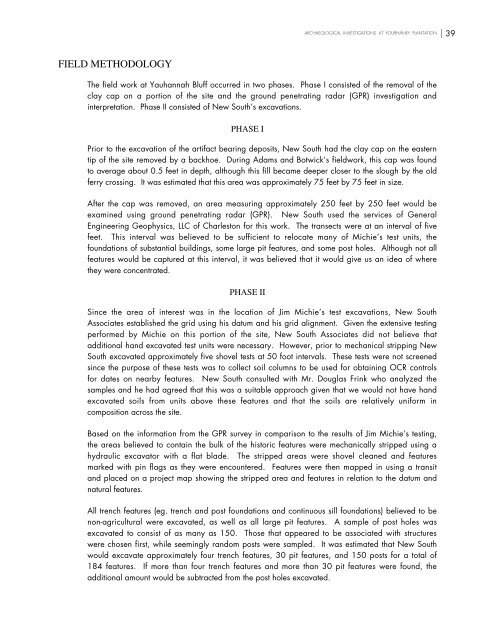Archaeological Investigations at Yourhaney Plantation (38GE18)
Archaeological Investigations at Yourhaney Plantation (38GE18)
Archaeological Investigations at Yourhaney Plantation (38GE18)
You also want an ePaper? Increase the reach of your titles
YUMPU automatically turns print PDFs into web optimized ePapers that Google loves.
ARCHAEOLOGICAL INVESTIGATIONS AT YOURHANEY PLANTATION39FIELD METHODOLOGYThe field work <strong>at</strong> Yauhannah Bluff occurred in two phases. Phase I consisted of the removal of theclay cap on a portion of the site and the ground penetr<strong>at</strong>ing radar (GPR) investig<strong>at</strong>ion andinterpret<strong>at</strong>ion. Phase II consisted of New South’s excav<strong>at</strong>ions.PHASE IPrior to the excav<strong>at</strong>ion of the artifact bearing deposits, New South had the clay cap on the easterntip of the site removed by a backhoe. During Adams and Botwick’s fieldwork, this cap was foundto average about 0.5 feet in depth, although this fill became deeper closer to the slough by the oldferry crossing. It was estim<strong>at</strong>ed th<strong>at</strong> this area was approxim<strong>at</strong>ely 75 feet by 75 feet in size.After the cap was removed, an area measuring approxim<strong>at</strong>ely 250 feet by 250 feet would beexamined using ground penetr<strong>at</strong>ing radar (GPR). New South used the services of GeneralEngineering Geophysics, LLC of Charleston for this work. The transects were <strong>at</strong> an interval of fivefeet. This interval was believed to be sufficient to reloc<strong>at</strong>e many of Michie’s test units, thefound<strong>at</strong>ions of substantial buildings, some large pit fe<strong>at</strong>ures, and some post holes. Although not allfe<strong>at</strong>ures would be captured <strong>at</strong> this interval, it was believed th<strong>at</strong> it would give us an idea of wherethey were concentr<strong>at</strong>ed.PHASE IISince the area of interest was in the loc<strong>at</strong>ion of Jim Michie’s test excav<strong>at</strong>ions, New SouthAssoci<strong>at</strong>es established the grid using his d<strong>at</strong>um and his grid alignment. Given the extensive testingperformed by Michie on this portion of the site, New South Associ<strong>at</strong>es did not believe th<strong>at</strong>additional hand excav<strong>at</strong>ed test units were necessary. However, prior to mechanical stripping NewSouth excav<strong>at</strong>ed approxim<strong>at</strong>ely five shovel tests <strong>at</strong> 50 foot intervals. These tests were not screenedsince the purpose of these tests was to collect soil columns to be used for obtaining OCR controlsfor d<strong>at</strong>es on nearby fe<strong>at</strong>ures. New South consulted with Mr. Douglas Frink who analyzed thesamples and he had agreed th<strong>at</strong> this was a suitable approach given th<strong>at</strong> we would not have handexcav<strong>at</strong>ed soils from units above these fe<strong>at</strong>ures and th<strong>at</strong> the soils are rel<strong>at</strong>ively uniform incomposition across the site.Based on the inform<strong>at</strong>ion from the GPR survey in comparison to the results of Jim Michie’s testing,the areas believed to contain the bulk of the historic fe<strong>at</strong>ures were mechanically stripped using ahydraulic excav<strong>at</strong>or with a fl<strong>at</strong> blade. The stripped areas were shovel cleaned and fe<strong>at</strong>uresmarked with pin flags as they were encountered. Fe<strong>at</strong>ures were then mapped in using a transitand placed on a project map showing the stripped area and fe<strong>at</strong>ures in rel<strong>at</strong>ion to the d<strong>at</strong>um andn<strong>at</strong>ural fe<strong>at</strong>ures.All trench fe<strong>at</strong>ures (eg. trench and post found<strong>at</strong>ions and continuous sill found<strong>at</strong>ions) believed to benon-agricultural were excav<strong>at</strong>ed, as well as all large pit fe<strong>at</strong>ures. A sample of post holes wasexcav<strong>at</strong>ed to consist of as many as 150. Those th<strong>at</strong> appeared to be associ<strong>at</strong>ed with structureswere chosen first, while seemingly random posts were sampled. It was estim<strong>at</strong>ed th<strong>at</strong> New Southwould excav<strong>at</strong>e approxim<strong>at</strong>ely four trench fe<strong>at</strong>ures, 30 pit fe<strong>at</strong>ures, and 150 posts for a total of184 fe<strong>at</strong>ures. If more than four trench fe<strong>at</strong>ures and more than 30 pit fe<strong>at</strong>ures were found, theadditional amount would be subtracted from the post holes excav<strong>at</strong>ed.







